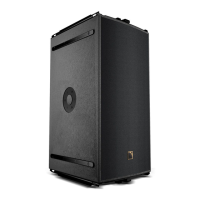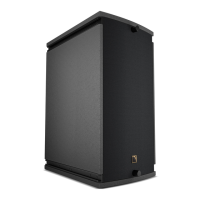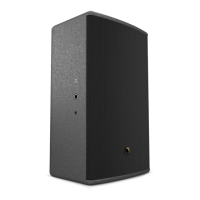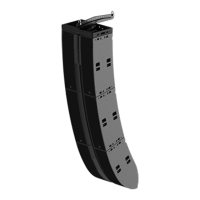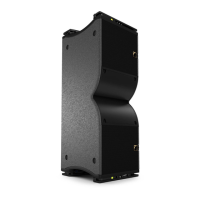L-ACOUSTICS ARCS Manual V2.0 2/13/2003 15
2. POWERING ARCS
It is important that power amplifiers with sufficient power are used to power ARCS since headroom is
much less likely to damage loudspeaker components than amplifier clipping. Apart from normal
standards regarding construction, protection, cooling and damping factor that are expected of any
professional sound reinforcement amplifier, the ARCS system has been calibrated to be used with
amplifiers with the following specifications:
GAIN STRUCTURE
All amplifiers should have 32 dB gain for all sections (sub, low and high). The limiter thresholds and
output channel gains of OEM digital crossover presets have been adjusted to be used with amplifiers
having 32 dB gain
.
LIMITERS
Peak limiters on all amplifier outputs with soft clipping characteristics; attack time less than 3 msec.
COOLING
Temperature speed-controlled fan recommended
POWER OUTPUT
Minimum and maximum power handling ratings for ARCS are as follows:
LF Section: 54 volts long term rms (pink noise with 6 dB crest factor)
375 Watts (rms), 1500 Watts (peak) at 8 ohms
HF Section: 29 volts long term rms (pink noise with 6 dB crest factor)
100 Watts (rms), 400 Watts (peak) at 8 ohms
In practice, L-ACOUSTICS specifies power amplifiers with power output equivalent to twice the RMS
power handling for the low section and equivalent to the peak power handling for the high section.
These requirements typically allow the same amplifier to be used for both LF and HF sections. For the
high section, since the drive level is attenuated relative to the low section by up to 10 dB at the
crossover to compensate for component efficiency differences, we can use the same amplifier since
we will never deliver full continuous power to the high section (i.e., due to the attenuation). The extra
available power translates to headroom for improved high frequency transient response.
Table 1 gives a summary of rms and peak power handling along with recommended amplifier output
power specifications for 1, 2 or 3 ARCS in parallel.
Table 1: Load and Power Ratings for ARCS
ONE ARCS TWO ARCS THREE ARCS FOUR ARCS
SECTION LOAD RMS PEAK REC'D LOAD RMS PEAK REC'D LOAD RMS PEAK REC'D LOAD RMS PEAK REC'D
LOW 8 375 1500
750
4 750 3000
1500
2.7 1125 4500
2250
215006000
3000
HIGH 8 100 400
400
4200800
800
2.7 300 1200
1200
2 400 1600
1600
For amplifying 2 ARCS in parallel, the recommended amplifier specifications are:
* LOW Amplifier Output Power: 1500 W into 4 ohms
* HIGH Amplifier Output Power: 800 W into 4 ohms
For amplifying 3 ARCS in parallel, the recommended amplifier specifications are:
* LOW Amplifier Output Power: 2250 W into 2.7 ohms
* HIGH Amplifier Output Power: 1200 W into 2.7 ohms
For amplifying 4 ARCS in parallel, the recommended amplifier specifications are:
* LOW Amplifier Output Power: 3000 W into 2 ohms
* HIGH Amplifier Output Power: 1600 W into 2 ohms
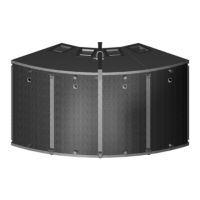
